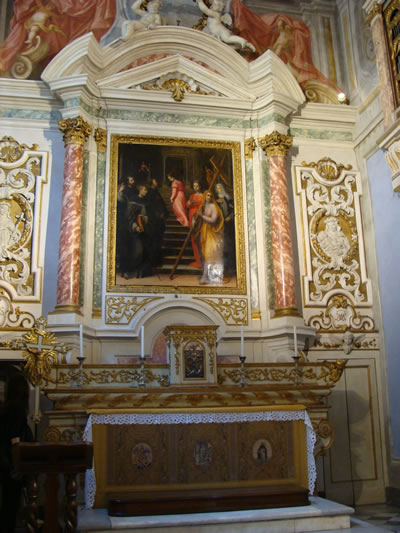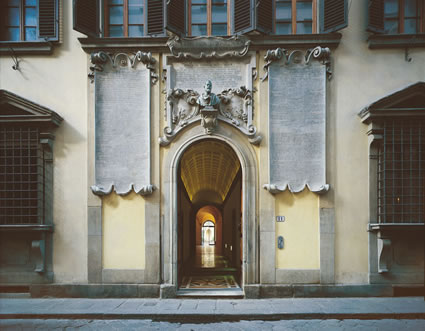
|
|
|
||||
|
 |
| Alfterpiece showing the restored painting of the admission of Mary into the temple in the convent of Santa Maria degli Angioli. |
After centuries of tourists descending on the city, is it still possible for the traveler to find places free of crowds?
Though it’s hard to believe, there are still many hidden treasures to be discovered.
Here are three among them:
1. Santa Maria degli Angiolini
As you leave the Piazza Signoria and the Duomo and head off into the quiet streets that lead past the Piazza Santissima Annunziata you will find, at the unimposing number 34 of Via della Colonna, the still functioning convent of Santa Maria degli Angiolini located in a beautifully luminous building with a lovely courtyard. While the convent hosts a university dormitory for female students since 1990 the nuns of the order of Saint Martha also take in women boarders who may while the time away in the ornate sitting rooms, practice their scales on a massive grand piano, and eat in a most elegant dining room.
 |
| Exterior of the Capella di Santa Maria degli Angioli |
But the real jewel of Santa Maria degli Angiolini is the baroque chapel which not only contains the oldest organ in Tuscany, but also a “miraculous” 15th or 16th century terracotta Virgin, a number of notable paintings, among them “the Presentation to the Temple” of a somewhat hesitant Mary carrying her schoolbooks and ascending the steps, a small sculpture of St John the Baptist and a Crucifix both by Giambologna, known to the casual tourist for his massive statuary in the Piazza Signoria. While the 1966 floods did considerable damage to the chapel, the artwork has been restored to its former glory thanks to the devotion of students and faculty of SACI (Studio Art Centers International), whose own imposing Palazzo dei Cartelloni on via San Antonino, nr. 11 was built to honor Galileo and whose façade bears the arms of the great Colonna family. SACI sponsors concerts of Baroque music, particularly that of female composers performed in the chapel. Indeed for those who wish to stay longer in Florence to study art there is no better recommendation for an art school, which has recently acquired and restored another enormous building, the Jules Maidoff Palazzo for the Visual Arts, Via Sant’ Egidio 14, where a graduate program in fine arts is being housed.
 |
| Palazzo dei Cartelloni in Florence: |
Amid its several treasures, the chapel of Santa Maria degli Angiolini contains the image of the Virgin standing on an unusual sphere, which, in the opinion of some experts suggest the possibility that the Mother Superior was aware of and ready to admit the (heretical) theories of Galileo. You can be assured that your visit will be undisturbed by others and you will be welcomed with real geniality by the nun in charge of admitting you.
 |
| Dining room for women boarders at convent of Santa Maria degli Angioli |
2. Teatro della Pergola
On Via della Pergola 18 stands the Teatro della Pergola, the historic opera house and the oldest theatre in Italy. Built in 1656 by a Medici cardinal, it was the very first theater built with superimposed tiers of boxes rather than the semi circular seating, in the Roman fashion. Primarily used as a court theatre for the Grand dukes of Tuscany, it was opened to the public in 1718 and here the operas of Mozart were first heard in Italy. Though the Pergola has undergone restoration in the 19th century, it still contains one original element: In the back of it—which , incidentally abuts the garden of SACI’s new palazzo—you will find the living quarters of the actors, who, in the 16 and 17th centuries were not allowed to rent in the city for fear of corrupting morality and were required to find lodging in the theatre!
3. Ospedale Santa Maria Nuova
The Church in the 1600’s also prohibited women from singing in church choirs or on the stage—hence the appearance of a tradition which was maintained for 200 years and more—that of the castrati, whose fate was associated with one of the oldest hospitals in Italy founded in the 1200’s. In the 1700’s 4,000 boys a year were being castrated in a production line in which 8 boys might be “gelded” at one time! The Ospedale Santa Maria Nuova, with its impressive century portico, founded in the 13th century by Portinari, the father of Dante’s beloved Beatrice, was designed as a place for the needy poor and seen by the 16th century as surpassing all others in its care for the sick. The Medici who had been instrumental in the patronage of the Hospital customarily asked the director to be the godparent of all Medici children.
Still it was up top individual families as well as corporate bodies to commission artistic works for both the male and the female wards and chapels for it was deemed that patients’ physical as well as spiritual health was of equal importance. The women’s ward contains fragments of original 15th century frescoes—the “Adoration of the Magi” and “The Last Supper” as well as images of a number of female saints.
It is also in the Ospedale of Santa Maria Nuova that Leonardo da Vinci was given permission to do a dissection on the body of an elderly patient he had befriended when, as an artist, he was denied the right by other doctors to ask for a corpse to investigate the lineaments of the human body.
***
In discovering these out of the way places so fully invested in the history of Florence (what in Florence is not, one might ask?) you will step into the past, which has not, as yet, been trampled by the feet of tourists that the American novelist Henry James called “Huns!”
Joanna Hubbs, PhD is the senior editor of Transtions Abroad and has both lived in and visited Florence extensively throughout her life.
|
|
| About Us | |
| Contact Us | |